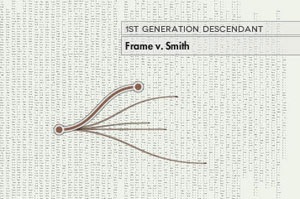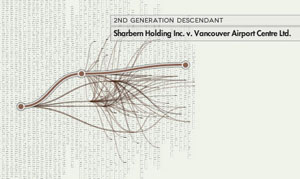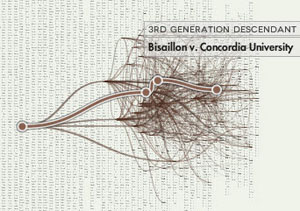There is a new, futuristic method to examine the relationship among Supreme Court of Canada decisions, using case citations. As counsel or research lawyers, when looking at any particular decision of interest, we need to understand the past and future context of the decision, i.e., (i) the underlying historical cases on which the decision relied, or which it distinguished, or otherwise considered, and (ii) the subsequent cases that similarly judicially considered the particular decision.
Until now, we would typically examine only the cases cited in a particular decision directly, and those that subsequently cite that decision directly. The information is presented textually in a case. We read the headnotes or body of a particular decision and use commonly available tools to note up that decision for subsequent cases that cited it.
The same goes if we want to branch out and examine how a particular decision affected future cases indirectly. We would need to note up those subsequent decisions to obtain a list of the cases that in turn cited them, and so on.
For ease of reference, let us call “ancestors” or “parents” the cases which a particular decision cites or on which it is based, and “descendants” or “children” the cases that subsequently cite or are otherwise based on a particular decision.
Since only the textual method has been available to us until now, we never really had a single representation of how a particular decision came to be or had an impact on future cases, directly and indirectly; all of a particular decision’s ancestors and descendants.
What if there was a way to look at the historical and future importance of a case using much more sophisticated tools? What if that information was presented in a two-dimensional graphical display that also incorporated information relating to a timeline, rate of citation, and, above all, indirect or “multi-generational” past and future citations of ancestors and descendants?
Will these elements, when incorporated and presented together through an interactive chart in the form of a “family tree” not give you a far deeper understanding of the real impact of any particular decision?
Think of it as the difference between simple and compound interest. The former is a linear calculation of interest, while the latter is a more involved calculation that accrues on the initial amount and accumulated interest at a certain frequency.
Enter a new sophisticated program called “Citeology,” which Toronto-based Autodesk Research developed for CanLII, based on a similar program it developed to examine the relationship among research publications in another field. CanLII’s Citeology creates a comprehensive and complex web of direct and indirect citation links among all Supreme Court of Canada citations — at present 9,101 cases and 27,747 citations among them — all in one interactive graphical interface!
There, I managed to describe what this program does without resorting to the techy lingo used in the little-available description of this fascinating new program. I call it the compound interest of examining the historical and subsequent treatment of a decision. The new program is publically available on
CanLII’s web site.
The cases are organized in vertical columns by year, with the first few characters of a case displayed. The most frequently cited decisions are located in the middle of their respective columns. The horizontal band displays the most frequently cited cases. By hovering your mouse over any particular dot on the chart, the full case name is displayed.
Once you select a case, if you hover your mouse over any other dot, the chart will automatically display a line representing the shortest path, if one exists, between those two cases.
At any point, you can generate a pdf of what appears on your screen to create a static record for your files.
Using it is quite simple. You need to understand some terminology, what the lines in the chart represent, and what a “generation” and a few other terms mean. The site provides a simple set of instructions, yet they are not readily understandable; at least they were not to me. I have reproduced those instructions below together with my translation of certain terms from “tech-talk” to “lawyer-talk.” (I added quotation marks to terms which I defined and square brackets containing my translation of those terms.):
Instructions:
• Click anywhere to select a “root case,” or use the search in the top left to enter a case name. [Root case is the particular main case you are looking at; the principle case.]
• The box below the search allows you to select the number of “generations” shown in reference to the “Root paper.” [A generation refers to a line of cases that directly cite a case. For example, a second generation includes a line of cases that cite other cases which, in turn, cite the principle case. Generations create indirect citations between cases, providing a much deeper understanding of what cases had affected or led to the principle decision, and how the principle decision had an impact on future cases. Root paper refers to root case.]
• Bottom left of the screen provides basic case info and a link to the case on CanLII.
Since a picture is worth a thousand words, let us roll up our sleeves and have a little demo. I thought of using a relatively simple precedent (so I thought!). The case is the only franchise decision to reach the Supreme Court:
Jirna v. Mister Donut of Canada. The decision is very short. It affirmed the decision of the Ontario Court of Appeal which, among other things, determined that, under typical terms of a franchise agreement, parties to a franchise agreement do not owe to one another a fiduciary duty.
There are approximately 70 Canadian decisions that have judicially considered
Jirna in one form or another (WestLaw indicates 69 decisions; CanLII only indicates 49 decisions).
The citation tools we normally use list the names and citations of those decisions, perhaps key words from the summary section of each, and perhaps even excerpts of paragraphs containing the highlighted reference to
Jirna. As with other Supreme Court decisions, many, if not most, of those decisions that have judicially considered
Jirna are not franchise cases. Nonetheless, they are interesting with respect to issues such as fiduciary obligations in contractual relations.
For purposes of our analysis, we will only focus on the Supreme Court decision, since the Citeology database is limited to Supreme Court decisions. Of the 69 decisions, only five are from the Supreme Court (WestLaw lists four; CanLII lists five). The five listed in CanLII, with their summary keywords, are the following:
1.
Frame v. Smith, [1987]
2.
Cadbury Schweppes Inc. v. FBI Foods Ltd., [1999]
3.
Hodgkinson v. Simms, [1994]
4.
Lac minerals ltd. v. International corona resources Ltd., [1989]
5.
Norberg v. Wynrib, [1992]
But in Citeology, an altogether different world appears. Here is what it shows:
| Generation 1: Listed are links to those five decisions which directly cited Jirna |
 |
| Generation 2: This is where we are in completely unchartered territory. Listed are links to numerous decisions which directly cited not the Jirna decision, but the “Generation 1” decisions. In other words, Jirna had an indirect impact on those cases. |
 |
| Generation 3: Things get even more crowded here. The web of cases continues growing exponentially. |
 |
On CanLii, I can hover my mouse over any dot along the complex web of links to see the name of the case and its generational link to
Jirna.
To me, a Citeology search augments current and traditional searches. It gives me an appreciation of the true reach of
Jirna, which I now realize is far beyond the five decisions that directly cited it. I can visually see how the principle enunciated in
Jirna, i.e., that contractual relations do not typically contain a fiduciary duty, has indirectly affected an enormous number of Supreme Court decisions that far transcend franchise law boundaries.
Enter the future of examining the real impact of cases.
{nomultithumb}



